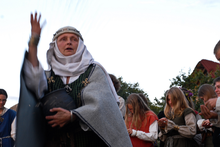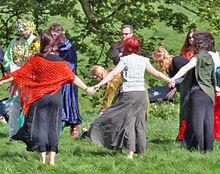Romanticism
Paganism re-surfaces as a topic of fascination in 18th to 19th century Romanticism, in particular in the context of the literary Celtic and Viking revivals, which portrayed historical Celtic and Germanic polytheists as noble savages.The 19th century also saw much scholarly interest in the reconstruction of pagan mythology from folklore or fairy tales. This was notably attempted by the Brothers Grimm, especially Jacob Grimm in his Teutonic Mythology, and Elias Lönnrot with the compilation of the Kalevala. The work of the Brothers Grimm influenced other collectors, both inspiring them to collect tales and leading them to similarly believe that the fairy tales of a country were particularly representative of it, to the neglect of cross-cultural influence. Among those influenced were the Russian Alexander Afanasyev, the Norwegians Peter Christen Asbjørnsen and Jørgen Moe, and the Englishman Joseph Jacobs.
Romanticist interest in non-classical antiquity coincided with the rise of Romantic nationalism and the rise of the nation state in the context of the 1848 revolutions, leading to the creation of national epics and national myths for the various newly formed states. Pagan or folkloristic topics were also common in the Musical nationalism of the period.
Contemporary Paganism
Main article: Neopaganism

Romuvan priestess conducting a ceremony in Lithuania. Romuva is the Neopagan revival of the ethnic religion of the Lithuanians and the Balts.
Many of the "revivals", Wicca and Neo-druidism in particular, have their roots in 19th century Romanticism and retain noticeable elements of occultism or theosophy that were current then, setting them apart from historical rural (paganus) folk religion.
Like Hinduism, there is no single founder, scripture or religious philosophy. Most Pagans, however, believe in the divine character of the natural world and Paganism is often described as an "Earth religion".

The hammer Mjöllnir is one of the primary symbols of Germanic Neopaganism. Pendants of the Mjöllnir are commonly worn amongst Germanic Neopagans.
In Iceland, the members of Ásatrúarfélagið account for 0.4% of the total population, which is just over a thousand people. In Lithuania, many people practice Romuva, a revived version of the pre-Christian religion of that country. Lithuania was among the last areas of Europe to be Christianized.
There are a number of Pagan authors who have examined the relation of the 20th-century movements of polytheistic revival with historical polytheism on one hand and contemporary traditions of indigenous folk religion on the other. Isaac Bonewits introduces a terminology to make this distinction,
- Paleopaganism: A retronym coined to contrast with "Neopaganism", "original polytheistic, nature-centered faiths", such as the pre-Hellenistic Greek and pre-imperial Roman religion, pre-Migration period Germanic paganism as described by Tacitus, or Celtic polytheism as described by Julius Caesar. Among extant "major religions", Bonewits would count as Paleopagan Hinduism as it stood prior to the Islamic invasions of India, Shintoism and Taoism.
- Mesopaganism: A group, which is, or has been, significantly influenced by monotheistic, dualistic, or nontheistic worldviews, but has been able to maintain an independence of religious practices. This group includes aboriginal Americans as well as Australian aborigines, Viking Age Norse paganism and New Age spirituality. Influences include: Freemasonry, Rosicrucianism, Theosophy, Spiritualism, and the many Afro-Diasporic faiths like Haitian Vodou, Santería and Espiritu religion. Isaac Bonewits includes British Traditional Wicca in this subdivision.
- Neopaganism: A movement by modern people to revive nature-worshipping, pre-Christian religions or other nature-based spiritual paths, frequently also incorporating contemporary liberal values at odds with ancient paganism. This definition may include groups such as Wicca, Neo-Druidism, Ásatrú, and slavic Rodnovery.
-
- polytheism: Pagan religions recognise a plurality of divine beings, which may or may not be considered aspects of an underlying unity (the soft and hard polytheism distinction)
- "nature-based": Pagan religions have a concept of the divinity of Nature, which they view as a manifestation of the divine, not as the "fallen" creation found in Dualistic cosmology.
- "sacred feminine": Pagan religions recognize "the female divine principle", identified as "the Goddess" (as opposed to individual goddesses) besides or in place of the male divine principle as expressed in the Abrahamic God.

No comments:
Post a Comment